Serbia 2009 "Museum Exhibits - Dinosaurs of Argentina in Belgrade"
| <prev | back to index | next> |
| Issue Date | 09.11.2009 |
| ID | Michel: 328-329; Scott: 488-489: Stanley Gibbons: 425-426; Yvert et Tellier: 323-324; Category: pR |
| Design | Nadezda Skocajic, Expert collaboration: Slavko Spasio, director of-the Natural History Museum in Belgrade. |
| Stamps in set | 2 |
| Value | 22 RSD - Herrerasaurus ischigualastensis 46 RSD - Giganotosaurus carolinii skeleton |
| Emission/Type | commemorative |
| Places of issue | Belgrade |
| Size (width x height) | 35.0 mm x 30.45mm |
| Layout | Printed in two Mini-Sheets of 9 stamps with one label in the middle
sheets with a label in the middle. On the labels Abelisaurus comahuensis and Megaraptor namunhuaiquii |
| Products | FDC x1, MC x2, MS x2 |
| Paper | Tullis Russell 100gr. |
| Perforation | 13.25 x 13.25 |
| Print Technique | Offset lithography |
| Printed by | Forum Novi Sad |
| Quantity | 28.000 sets |
| Issuing Authority | Jugomarka |
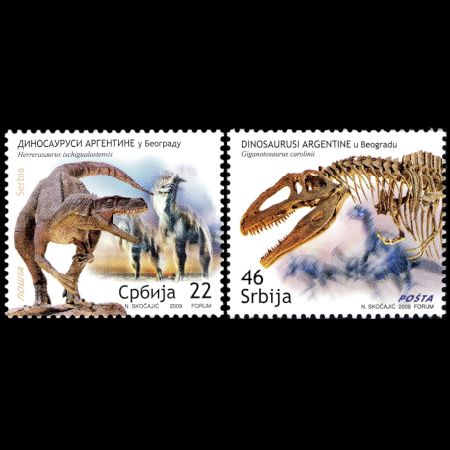
On November 11th 2009, Post Authority of Serbia - Jugomarka, issued the set of two stamps of dinosaurs: "Dinosaurs of Argentina in Belgrade". One of the stamps shows reconstructions of Herrerasaurus ischigualastensis, while the other stamp shows a skeleton of Giganotosaurus carolini. Stamps were issued in Mini Sheets of 9 stamps and 1 tab (5x2) in the middle of the second row.
The exhibition "Dinosaurs of Argentina - Giants of Patagonia" was brought to Belgrade as a result of cooperation between GGPCLA Grupo Cultural from Argentina and Belgrade Natural History Museum.
Almost all fossils shown in the exhibit were discovered in the province of Neuquen at the National Parks of Talampaya and Ischigualasto, also known as "Valley of the Moon".
| "Valley of the Moon" on stamps of Argentina | ||
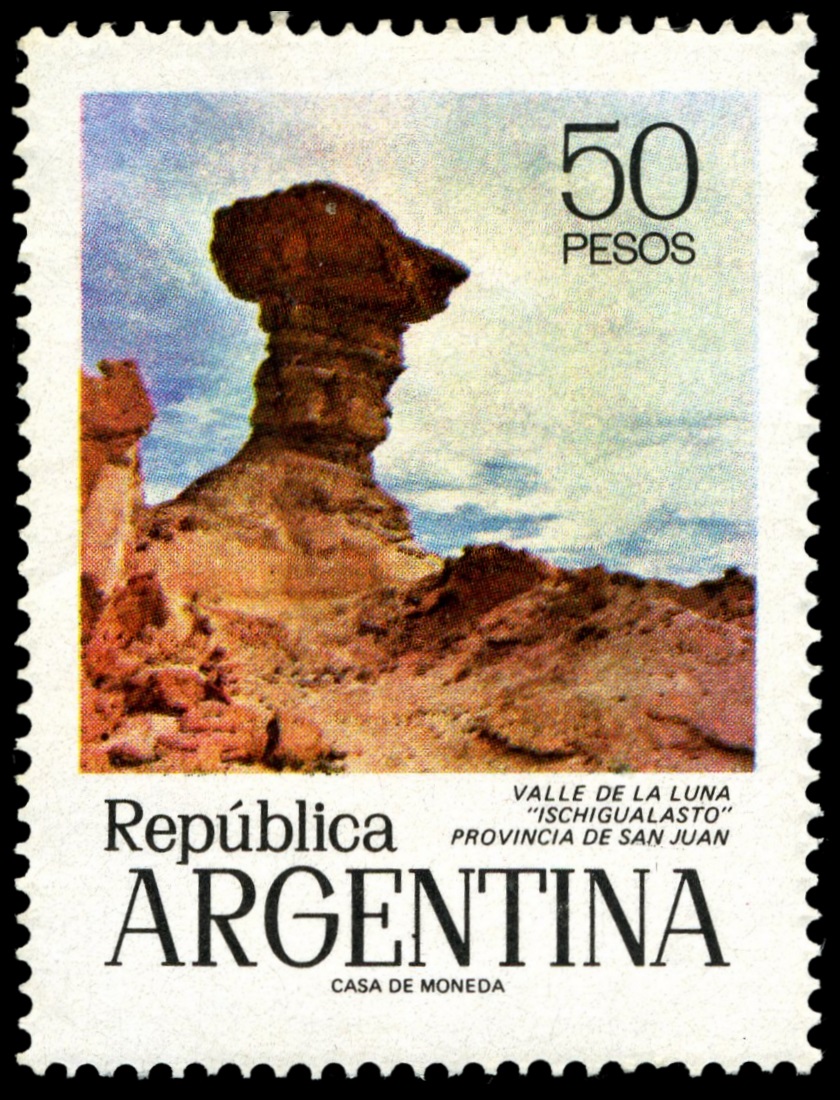 |
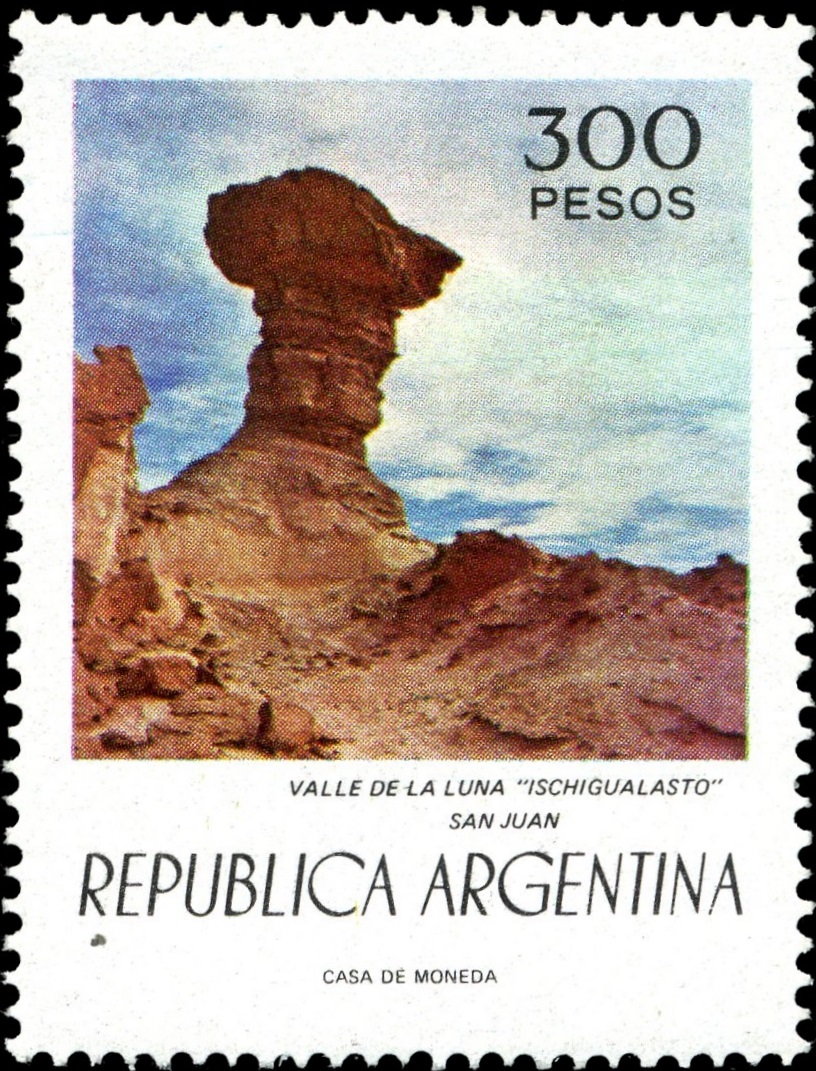 |
 |
| Argentina 1976, MiNr.: 1234, Scott: 1050. | Argentina 1977, MiNr.: 1288, Scott: 1108. | Argentina 2003, MiNr.: 2841, Scott: 2248e.
|
Dinosaurs belong to the reptile family which were extinct 65 million years ago (60 million years before the appearance of the first hominid). The word dinosaur (terrible lizard) was used for the first time in 1841 (just one year after the first adhesive postage stamp, the Penny Black, was issued) by Sir Richard Owen, Professor of Anatomy of the British Museum.
The exhibition presented 20 species of dinosaurs and around 40 skeletons or skeleton parts, dinosaur eggs, nests, craniums, bones, footprint replicas and reconstructions of life in the past. The exhibition's most attractive part consisted of the complete skeletons of 10 dinosaurs: the bloodthirsty carnivore Giganotosaurus (14 meters long, shown on one of the stamps), herbivore Rabbachisaurus (17 meters long from the cranium to the last tail vertebrae, this sauropod is one of the most complete sauropod skeletons discovered in South America at the time the stamps were issued), Camotaurus (7.5 meters long), Herrerasaurus (2,5 meters long, shown on one of the stamps) etc. The Belgrade exhibition also featured a premiere: a nine-meter Megaraptor, with claws half a meter long.
Dinosaurs discovered in Patagonia, southern region of Argentina, are considered to be the oldest dinosaurs that ever lived on our planet, during a period which lasted more than 180 million of years.
The Natural History Museum also prepared a mini - exhibition "Serbia in the Time of Dinosaurs" which features exhibits of the world of fossils that lived in Mesozoic Era, on the modern territory of Serbia, which was, at that time, mostly under the sea. That is the reason why a large number of fossils belong to invertebrates (snails, shells, sea urchins, ammonites). There was not much data about the dinosaurs. The most reliable facts were gathered on the Balkan mountain where footprints of very small dinosaurs (Thecodontosaurus) were found in 200 million years old rocks.
The following five dinosaurs were depicted on the stamps and the labels
Herrerasaurus ischigualastensis - depicted on the stamp with face value of RSD 22.
 |
| Herrerasaurus ischigualastensis on stamp of Serbia 2009 MiNr.: 328, Scott: 488. |
 |
| Giganotosaurus carolinii on stamp of Serbia 2009 MiNr.: 329, Scott: 489. |
Its name means "Herrera's lizard", after the rancher, Victorino Herrera, who discovered the first specimen near the city of San Juan, Argentina in 1959. All known fossils of this carnivore have been discovered in the Ischigualasto Formation of Carnian age (237-227.3 million years ago) in north-western Argentina. The type species, Herrerasaurus ischigualastensis, was described by Osvaldo Reig in 1963 based on very fragmentary remains and is the only species assigned to the genus. In 1983, an almost complete skeleton and skull of Herrerasaurus was discovered.
The teeth of Herrerasaurus indicate that it was a carnivore, probably hunting small to medium size herbivore dinosaurs, such as Pisanosaurus. It was a fast running predator, probably attacking by wit its fore and hind limbs, then smashing the victims with powerful claws.
Giganotosaurus carolinii - depicted on the stamp with face value of RSD 46.
Giganotosaurus is a genus of large theropod, carnivorous, dinosaur that lived in what is now Argentina, during the early Cenomanian Age of the Late Cretaceous, approximately 99.6 to 95 million years ago. The holotype specimen was discovered in the Candeleros Formation, near Lake Ezequiel in Argentina’s Patagonia region, in 1993 and is almost 70% complete. It was discovered by Ruben Carolini, a mechanical engineer while working on the El Chocon Dam, who became director of the E. Bachmann Museum at Villa El Chocon later. The animal was named Giganotosaurus carolinii in 1995; the genus name translates to "giant southern lizard", and the specific name honors the discoverer.
A dentary bone, a tooth, and some tracks, discovered before the holotype, were later assigned to this animal. The genus attracted much interest and became part of a scientific debate about the maximum sizes of theropod dinosaurs.
Giganotosaurus is thought to have reached a length of 12−13 meters, 7 meters height in withers and a weight of 7-8 tonnes. Giganotosaurus is often compared to Tyrannosaurus rex because of their similar size and predatory habit, but Giganotosaurus lived tens of millions of years earlier than Tyrannosaurus rex. Giganotosaurus lived on the South American continent, while Tyrannosaurus rex lived in the North America.
Abelisaurus comahuensis - depicted on one of the labels.
 |
| Abelisaurus comahuensis on a label of Serbia 2009 |
 |
| Megaraptor namunhuaiquii on a label of Serbia 2009 |
 |
| Gasparinisaura cinncosaltensis on cachet of FDC of Serbia 2009 |
The species name means "Abel's lizard from the Comahue region" and commemorate the discoverer Prof. Roberto Abel, director of the Museo de Cipolleti, where the holotype is kept. Abel discovered the skull at the "Cantera de la Pala Mecanica" site in the Lago Pellegrini quarries. The dinosaur was named and described by Argentine paleontologists Jose Bonaparte and Fernando Emilio Novas in 1985.
Megaraptor namunhuaiquii - depicted on one of the labels.
Megaraptor is a genus of large theropod dinosaur that lived during the Late Cretaceous, 92-89 million years ago. Its fossils have been discovered in the Patagonian Portezuelo Formation of Argentina. The type specimen of Megaraptor consists of a fragmentary assemblage of limb bones, discovered in 1996 by Argentine palaeontologist Fernando Emilio Novas.
In 1998, when Novas described and named the dinosaur, he believed that a large claw found at the site came from the animal's foot and therefore the dinosaur is related to North American Velociraptor or Utahraptor. He named it Megaraptor namunhuaiquii, where mega derives from Greek word "large" and the Latin raptor meaining "thief". The species name derives from the Mapuche namun "foot" and huaiqui "lance".
In the early 2000s the second specimen, including articulated hand, of Megaraptor was discovered at Costa Dinosaurio in Barreales Lake. The specimen was described by another Argentinian paleontologist Jorge Orlando Calvo in 2004. It was shown that the claw belongs not to the foot, but rather to a finger in the hand. Distinguished from many other theropod dinosaurs who lived during the Cretaceous, Tyrannosaurus rex for example, the hands of Megaraptor were large and powerful. The hand claws were very long and strongly curved, with the claw of the first finger measuring 35 cm.
Its skull was long, low, and slender. Similar to tyrannosaurs, it had small, conical teeth at the front of its jaws, and longer, more curved teeth near the back. Due to the fact that no complete skeleton of Megaraptor is known to date, its anatomy has been pieced together over the years through only a few fragmentary specimens. It has been estimated that Megaraptor measured between 6 and 9 meters in length, and weighed around 1 tonne.
Gasparinisaura cinncosaltensis - First-Day-of-Issue Postmark and the cachet of FDC cover.
Gasparinisaura was a very small, bipedal herbivore, a dog-size dinosaurs with estimated length of 60 cm and weight of 13 kg.
Its fossils were discovered in 1992 ear Cinco Saltos in Río Negro Province, Argentina and was described by Rodolfo Coria and Leonardo Salgado in 1996. The generic name honors Argentine palaeontologist Zulma Brandoni de Gasparini. The specific name refers to the discovery location - Cinco Saltos.
Gasparinisaura lived during the Late Cretaceous, 89-74 million years ago. The finds of numerous specimens at the same place suggests Gasparinisaura formed groups with narrow social bonds. Its diet was composed of plants such as conifers, cycads and gingkoes.
Products and associated philatelic items
| FDC | First-Day-of-Issue Postmark | Maxi Cards |
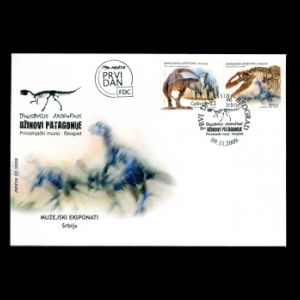 |
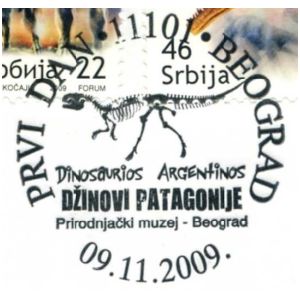 |
 |
| The reverse side is here | The reverse side is here | |
| Mini-Sheets | Souvenir Folder | Example of circulated cover |
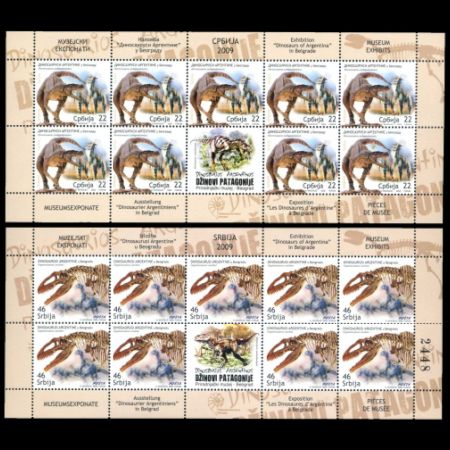 |
 |
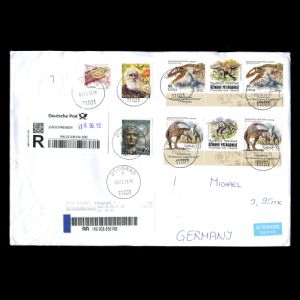 |
References
 |
| "Dinosaurios Argentinos", by Fabio Frachtenberg, Jorge Calvo, Oscar A. Frachtenberg, issued by the Natural History Museum of Belgrade in 2009. |

|
- Technical details and description of the exhibition:
back side of FDC,
Serbia Today from June 23rd, 2009,
Like flowers and butterflies blog (including many photos),
colnect.
"Dinosaurios Argentinos", by Fabio Frachtenberg, Jorge Calvo, Oscar A. Frachtenberg, issued by the Natural History Museum of Belgrade in 2009, ISBN: 978-86-82145.19-6 - Herrerasaurus ischigualastensis: Wikipedia Encyclopedia Britannica UCMP Berkeley
- Giganotosaurus carolinii
Wikipedia Encyclopedia Britannica - Abelisaurus comahuensis
Wikipedia Encyclopedia Dinozaury The Dnosaurs - Megaraptor namunhuaiquii
Wikipedia - Gasparinisaura cinncosaltensis
Wikipedia Stephen Poropat — Palaeontologist
Acknowledgements
- Many thanks to Dr. Peter Voice from Department of Geological and Environmental Sciences, Western Michigan University, for reviewing the draft page.
- Many thanks to "Serbian Stamps" Shop for help finding information about these stamps.
| <prev | back to index | next> |